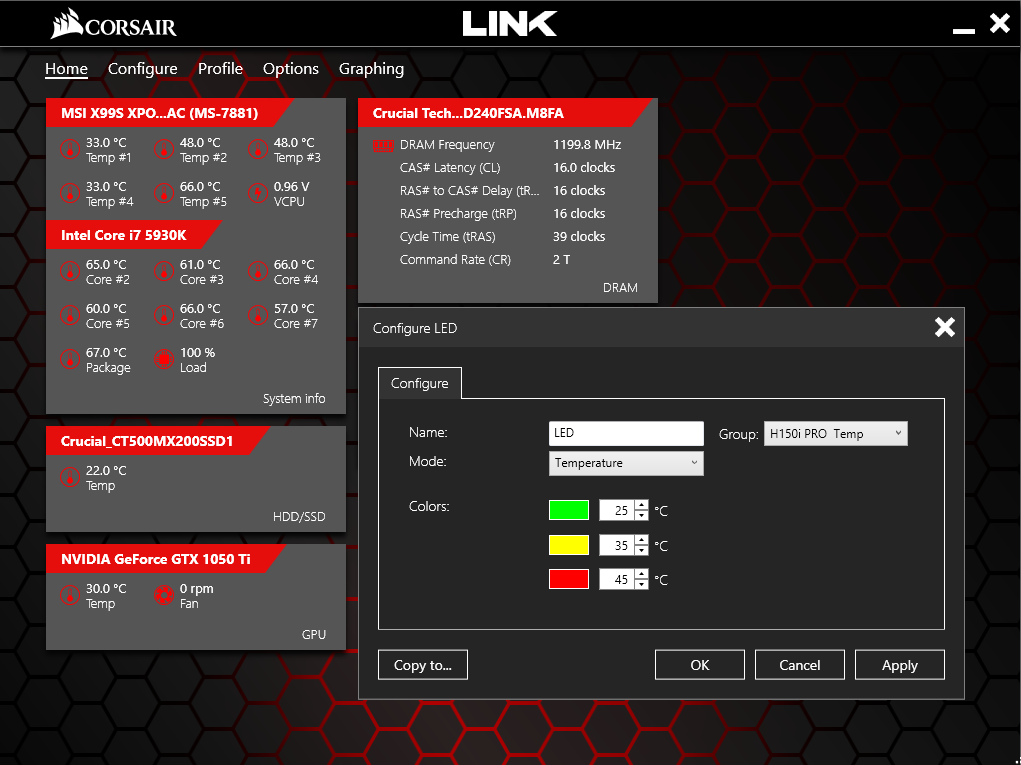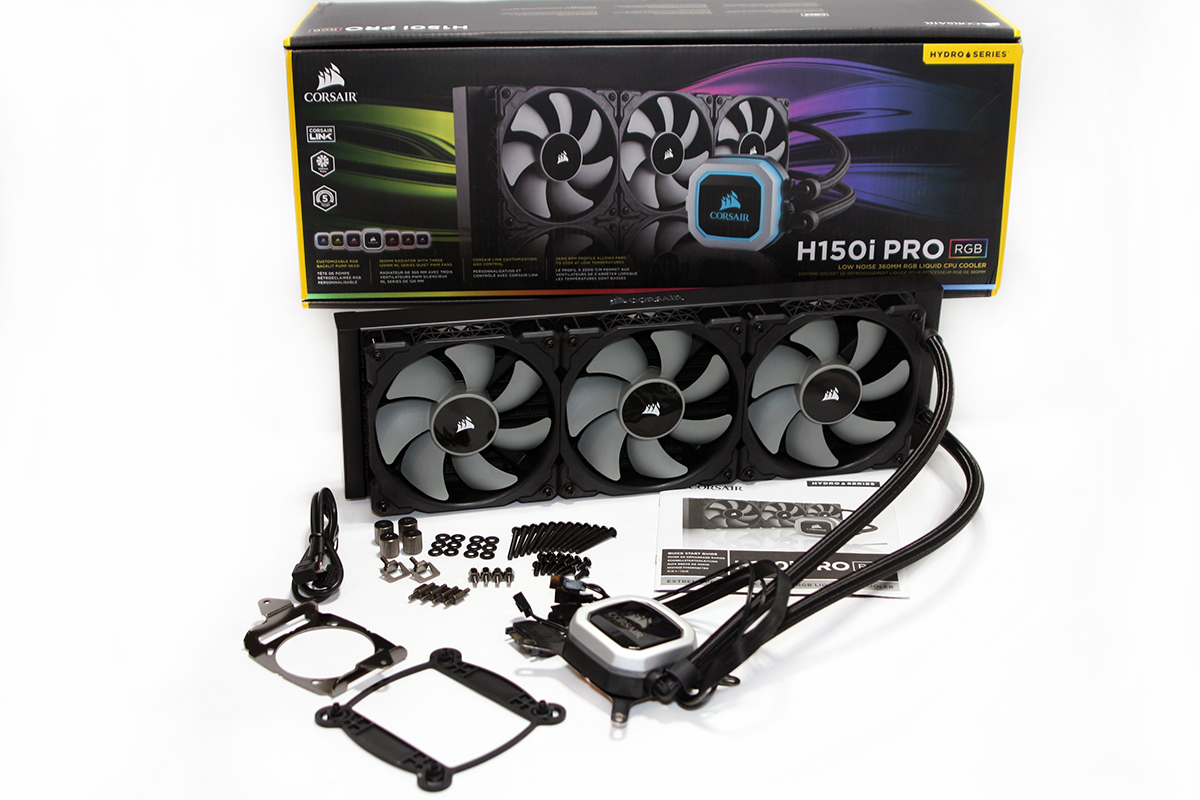Early Verdict
A large, well rounded cooling solution that provides the most value when taking advantage of the Corsair LINK software to manage the H150i Pro. Quiet, non-RGB fans mean a near-silent user experience and lower, overall cost than similar cooling solutions.
Pros
- +
Low noise levels, even at full speed
- +
LINK software provides enhanced configuration and whole-system monitoring
- +
5 year warranty
Cons
- -
Load temperatures were a bit warmer than others tested
- -
Although might be a PRO for some, RGB lighting is limited to pump only
- -
Very large, 360 radiator requires 3x120mm adjacent fan mounts
Why you can trust Tom's Hardware
Features & Specifications
Recently, we've seen an influx of larger All-In-One (AIO) closed-loop liquid CPU coolers that are designed to appeal to those who seek the highest possible CPU clock speeds and who want a dependable, bolt-on cooling solution to help them do so. Although AIO cooling systems based on single and double 120mm radiator sizes have been mainstream for quite some time, we are seeing a trend of double 140mm and even triple 120mm heat exchangers to cope when additional cooling potential is needed.
Now, Corsair enters the large AIO cooler arena with the H150i Pro, a triple 120mm radiator product that includes all the typical Corsair features with which we’ve become familiar. While the radiator is almost overwhelming in length, the name ‘H150i Pro’ is quite the opposite, making it simple to remember. And, by supporting almost all current AMD and Intel CPU sockets, the only limitation for the H150i Pro is having the room to contain it.
Specifications
The H150i Pro comes boxed packaged with the usual assortment of Corsair-esque snap rings and brackets for socket compatibility that twist-lock into the bottom of the pump unit. The pump is secured via heavy, nickel-plated thumbscrews that thread down over mounting offset posts. Three ML Series 120mm PWM fans rated at 47.3 CFM at 1600 RPM will adorn the 360 radiator to provide airflow and likewise require three 120mm adjacent fan mounts for support.
The H150i Pro pump unit draws power from an integrated SATA 12v adapter. A Micro-B to USB header cable is included to allow granular control of the H150i Pro pump and fans using the Corsair LINK software suite, although they can simply be controlled via motherboard PWM header. A triple, 4-pin ribbon cable protrudes from the pump to allow the three 120mm fans to be controlled with the LINK software or chosen PWM header. The Corsair branded acrylic pump top is ringed with RGB lighting and, as you may have guessed, also gets full customization within the LINK software UI.
The pump cold plate arrives with a factory-applied splotch of thermal compound, which seemed a bit dry and chalky. The cooler also ships with the Intel mounting plate attached, which happens to also be correct for our overclocked 2011-v3, 6-core i7-5930k. Secured with recessed screws, the copper base is milled very smooth, but not quite to a mirror finish. And while radiator tubing connections are fixed, the pump tubing connections shown above pivot to allow movement during installation.
A common, 240 (2x120mm) AIO cooler occupies a significant amount of PC case area to house the radiator, so the 360 radiator used on the H150i Pro requires tactful installation and planning. Corsair utilizes aluminum for the core and fins for this cooler, which should come as no surprise since most (if not all) of the company's AIO offerings are also engineered using the same material for the heat exchangers. The semi-gloss black paint is accented by nickel-plated adhesive Corsair logos along either side. That’s correct: we said nickel plated logos; not paint or stickers.
We setup the H150i Pro in the top of our Corsair Graphite 760T case with all fans oriented to push and exhaust warm air through the top vents of the case, the same manner in which we test all AIO coolers. When it's finally mounted above our MSI X99S XPower AC ATX motherboard, you get the full sense of the sheer size of the H150i Pro.
Get Tom's Hardware's best news and in-depth reviews, straight to your inbox.




Corsair LINK software is installed like any other Windows application and can be setup to run at system boot. LINK lets you control and view fan curves, temperature history graphing, configure RBG lighting, and manage pump RPM. One lighting configuration that we found interesting allows pump RGB color changes depending on detected thermal levels of CPU cores, motherboard sensors, or coolant temperature.
MORE: Best CPU Cooling
MORE: How To Choose A CPU Cooler
MORE: All Cooling Content
- 1
- 2
Current page: Features & Specifications
Next Page Comparison Coolers, Testing Results & Conclusion
Garrett Carver is a contributor for Tom’s Hardware, primarily covering thermal compound comparisons and CPU cooling reviews; both air and liquid, including multiple variations of each.
-
Matt_550 Wow, temps were 10C higher than even the leading 280mm CPU coolers. That's not good...Reply -
rubix_1011 My thinking is that airflow might be the overall main culprit since a 280 and 360 radiator are very close in actual surface area and overall heat exchanger volume. Would be a very simple theory to test :)Reply -
mcconkeymike I had to change out the fans on my Corsair H100i due to noise and poor cooling. Once I did I noticed a decent difference. I'm betting they are putting the low end fans on the cooler and if you put some good ones on there you'd be in good shape. That would screw up the price/performance ratio, but if you are a Corsair junky, then there you go.Reply -
thrakazog I've seen a few reviews today on this AIO, and I'm wondering if you tested with the pump set to half speed quiet mode only. All the other test results I've seen show this AIO performing quite well compared to the other AIO's. I've seen one review that tested both the normal performance mode for the pump, and the quiet mode, and only their quiet mode low speed pump results have matched the results in this review.Reply -
rubix_1011 I had the pump set to full speed according to the LINK software; it was set for all tests in this configuration.Reply -
melvis72 Would be interesting to see if a push pull configuration would give some lower temp ranges and by how much. I also wonder if the stock fans are hindering lower temps but like Thrakazog said I also seen reviews that showed it fairing better against other AIO coolers.Reply -
FD2Raptor Reply20573613 said:I've seen a few reviews today on this AIO, and I'm wondering if you tested with the pump set to half speed quiet mode only. All the other test results I've seen show this AIO performing quite well compared to the other AIO's. I've seen one review that tested both the normal performance mode for the pump, and the quiet mode, and only their quiet mode low speed pump results have matched the results in this review.
Gamer Nexus : 5930k @ 3.8Ghz 1.14V
EVGA 280 (2200rpm) : 32.86 LOAD, over ambient
NZXT X61 (1700rpm) : 36.94 LOAD, over ambient
Corsair H150 (1600rpm) : 35.80 LOAD, over ambient
Corsair H150 "quiet" (1600rpm) : 49.91 LOAD, over ambient
Toms : 5930k @ 4.2Ghz 1.2V
EVGA 280 (2280rpm) : 37 LOAD, over ambient
NZXT X61 (1980rpm) : 41 LOAD, over ambient
Corsair H150 (1600rpm) : 55 LOAD, over ambient
either those extra OC and voltage is already too much for the H150 or something is off here... -
envy14tpe Something seems wrong in your testing. I haven't seen a single review with comparable cooling numbers.Reply -
Randi Poling Swap the fans, they use the bare bones, bottom of the barrel fans for their AiOs. I swapped out the stock fans with some LP Corsair White LED fans and i noticed a difference. Swap the fans and try the tests over.Reply





